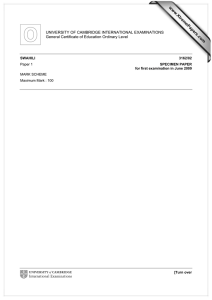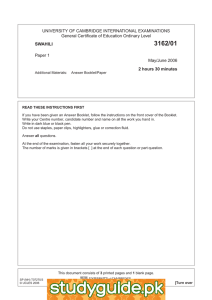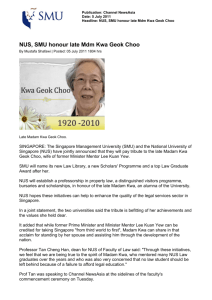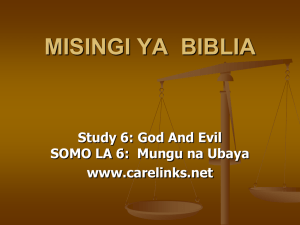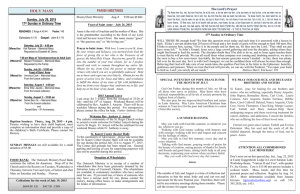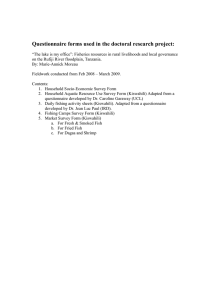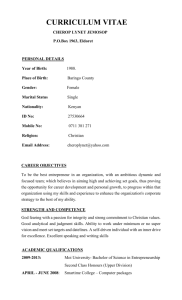www.xtremepapers.net UNIVERSITY OF CAMBRIDGE INTERNATIONAL EXAMINATIONS General Certificate of Education Ordinary Level
advertisement
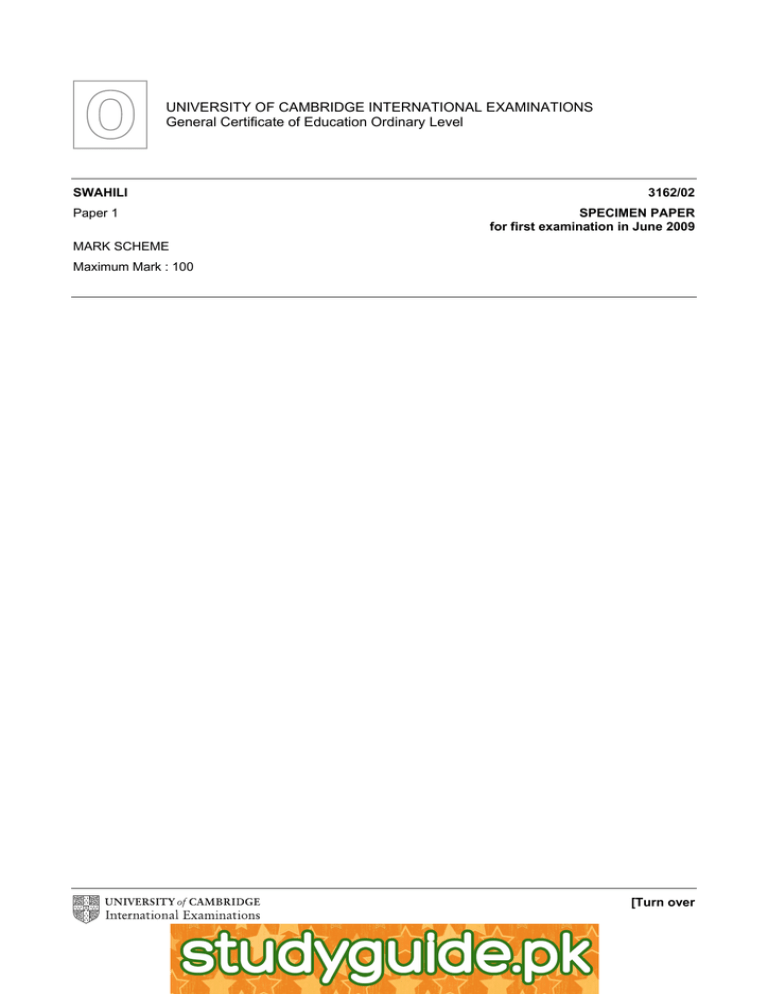
UNIVERSITY OF CAMBRIDGE INTERNATIONAL EXAMINATIONS General Certificate of Education Ordinary Level SWAHILI Paper 1 3162/02 SPECIMEN PAPER for first examination in June 2009 MARK SCHEME Maximum Mark : 100 [Turn over www.xtremepapers.net Question 1: Translation from Swahili into English. stimulus Rafiki yangu na mimi tulikwenda kutembea jana. Tulikwenda kwenye msitu uitwao Jozani uliopo kwenye kisiwa cha Unguja. Ingawa msitu wa Jozani si mkubwa, una vitu vya aina nyingi ambavyo watu huja kuvitazama kutoka pande zote za dunia. Kwanza, tutaje miti. Inasemekana kwamba kuna aina za miti inayozidi mia. Wataalamu wa sayansi wengi wamekuwa wakija Jozani. kwa muda wa miaka mingi kuchunguza aina mbali mbali za miti hii. Wanataka kujua hasa kama miti hii ina uwezo wa kutumika katika utibabu wa magonjwa fulani. Pili, msitu wa Jozani una ndege wa aina nyingi. Watazamaji wa ndege huja na darubini zao, wakakaa tuli kwa masaa mengi kuwapiga picha kuwachora na kupata raha ya kuwaona ndege wenye uzuri wenye uzuri wenye sifa nyingi Jozani pia kuna kima wa aina ya ‘Colobus’ wenye rangi nyekundu. Tuliwaona wakiruka kwenye miti, wakicheza. Tulikaa Jozani kwa muda wa masaa matatu. Baada ya kuondoka Jozani, tulikwenda Chwaka tukaogelea kwenye bahari na kupunga upepo wa pwani. Tulipata nafasi pia ya kwenda baharini na mvuvi katika mashua yake. Juma alivua samaki wawili, lakini mimi sikupata kitu. translation My friend and I went for a walk yesterday. We went to a forest called Jozani which is on the island of Zanzibar. mark [1] [1] Although the Jozani Forest is not large, it has things/species of different kinds which people from different parts of the world come to see. First, let us mention the trees. It is said that there are more than hundred types of trees. Many scientists have been coming to Jozani for a period of many years to research different types of trees. [1] [1] [1] [1] [1] [1] They especially want to know if these trees could be used in curing certain illnesses. Secondly, Jozani Forest has many (different) kinds of birds. Bird watchers come with their binoculars and sit still for many hours in order to photograph them, to draw them, and to look at birds whose beauty has been much praised. Jozani also has many Colobus monkeys which are red in colour. We saw them jumping in trees, playing (about). We stayed at Jozani for a period of three hours. After leaving Jozani, we went to Chwaka, swam in the sea and took/enjoyed the sea breeze. We had the opportunity of going out to sea with a fisherman in his boat. [1] [1] [1] [1] [1] [1] [1] [1] [1] [1] [1] Juma caught two fishes, but I caught none. [1] [Total : 20] www.xtremepapers.net Question 2: Translation from Swahili into English. stimulus Hundreds of accidents happen every day in homes all over the country. translation Mamia ya ajali/maajali hutokea kila siku majumbani nchi nzima. It is said that more people are involved in accidents at home than anywhere else. Most accidents can be prevented Inasemekana watu wengi wanahusika na/wanapata ajali nyumbani kuliko ko kote kwengineko. Aghalabu ajali zote zinaweza kuepukwa Ikiwa watu watafikiria yale wafanyayo au yale ambayo huenda watoto wao wakafanya wakiachwa peke yao. Ajali zinaweza kutokea po pote nyumbani, ingawa jikoni, chooni (au chumba cha kuogea), na ngazini inasemekana ndipo hasa mahala pa hatari Kwa ajili ya watoto na watu vizee (au wazee). Kwa sababu hii, inafurahisha kuona kwamba halmashauri nyingi za jiji zinajitahidi Kuwaelimisha watu kuhusu jambo hili. Wamechapisha vijitabu vidogo vinavyoeleza namna ya kuepuka na ajali. Wazazi wanaonywa kutoweka visu katika vijisanduku vya/mitoto ya meza na wasiviache mahala ambapo watoto wangeweza kuvipata. Nasaha kama hiyo pia inatolewa kuhusu madawa. Watu wazee waliodhaifu waishike ngazi kwa nguvu/ imara wanapopanda au kushuka ngazi. if people give some thought to what they are doing or to what their children are likely to do if left on their own. Accidents can occur anywhere in the home, although the kitchen, the bathroom and the stairs are said to be particulalry dangerous places for children and the elderly. For this reason, it is pleasing to see that many city councils are now making an effort to educate people on this subject. They have published small booklets which explain how accidents can be avoided: Parents are warned to keep sharp knives in drawers and not to leave them in places where children can reach them. Similar advice is given in relation to medicines. The elderly who are weak should hold firmly to the stair-rail when climbing up or going down the stairs. Very young children must have a parent with them in the bathroom, especially if there is a large bucket of water in the room. mark [1] [1] Watoto wadogo sana lazima wawe na mmoja wa wazee wao wanapokuwa chooni/kwenye chumba cha kuogea, hasa ikiwa ipo ndoo kubwa ya maji hapo chumbani. [1] [1] [1] [1] [1] [1] [1] [1] [1] [1] [1] [1] [1] [1] [1] [1] [1] [1] [1] [1] [1] [1] [1] [1] [1] [1] [1] [1] [Total :30] www.xtremepapers.net Question 3: Comprehension Candidates should answer in full sentences and in their own words as much as possible (see banded mark scheme for Language below). Content (20 marks) This mark scheme is not exhaustive; it is in note-form and only serves as a guide for markers. Candidates must attempt to answer the questions in full sentences and avoid copying word-for-word from the text. (a) Bi Agnes alitoa hotuba yake wakati gani, na aliwahutubia nani? [2] Alitoa hotuba yake mwisho wa kongamano alipoifunga [1] Aliwahotubia wanawake walioshiriki katika kongamano hiyo [1] (b) Kwa nini waziri anazitaka taasisi zisiwe na woga wa kuwakopesha fedha wanawake? Toa sababu mbili. [2] Wanawake wanalipa deni [1] Wanawake wanatumia mikopo kwa madhumuni walyokusudia [1] (c) Soma tena kifungu hiki kutoka mstari 9 hadi mstari 13. Eleza kikamilifu kwa nini Bi Agnes anawahimiza wanawake kuchukua mikopo. [4] lli wanawake wawe wajasiri wa kuanzisha biashara [1] Ili wanawake wasinyanyaswe [1] Ili sauti zao zisikike [1] Ili waweze kujitegemea [1] (d) Kongamano imewafundisha wanawake mbinu mbili za kuanzisha biashara. Zitaje hizo. [2] Wapate wazo la kufanya biashara [1] Wajiunge katika vikundi ili wapate mitaji [1] (e) Hadithi ya kuku na ndege aliyoitoa Bi Agnes imekusudiwa kufundisha nini? Taja mafunzo matatu. [3] Wanawake waache woga [1] Wafanye bidii katika biashara zao [1] Wajiamini [1] (f) Nani hufaidika kwa mapato ya biashara za wanawake? Familia za wanawake [1] Taifa [1] www.xtremepapers.net [2] (g) Eleza wanawake wanajifunza nini kutokana na mfano binafsi wa Bi Agnes. Taja mambo manne. [4] Answers must be based on evidence from the text. Up to a maximum of four from any of the five following examples: Hata mwanamke akizaliwa katika mazingira ya umasikini, anaweza kufaulu katika Biashara [1] Mwanamke awe na bidii ya kufaulu [1] Asikate tama [1] Kujua kwamba hakuna njia ya mkato ya kufaulu [1] Mwanamke anaweza kufaulu katika siasa [1] (h) Eleza umuhimu wa kusajili biashara za wanawake katika ngazi husika. [1] Ni rahisi kuipatia mkopo biashara iliyosajiliwa kwenye ngazi husika [1] [Total for content : 20] Language (5 marks) The language mark is awarded on the basis of the repsonse to the questions as a whole. 5 Excellent 4 Good 3 Adequate 2 Weak 1 Poor 0 Clear, carefully chosen language in the candidate’s own words with complex syntax where appropriate. Varied, precise vocabulary. Hardly any or no technical errors. Clear, appropriate language, mostly in the candidate’s own words. Appropriate vocabulary. Few technical errors. Language generally appropriate, but unsophisticated and generally simple syntax. Adequate vocabulary. Some technical errors. Occasional reliance on lifting from the passage. Unsophisticated language, not always appropriate. Very simple syntax with some clumsiness. Thin vocabulary. A number of technical errors. Often reliant on lifting. Thin, inappropriate use of language. Confused and obscure. Many errors. In a large number of cases there will be considerable lifting. The mark of 0 is reserved for answers for which there is no language to be credited. Total : 20 for Content + 5 for language = 25 www.xtremepapers.net Question 4: Composition BAND MARKS DESCRIPTORS • 1 25-23 • • 2 22-20 • • 3 19-17 • • 4 16-14 • Apart from very occasional slips, the language is accurate. Sentence structure is varied and demonstrates the candidate’s skill to use different lengths and types of sentences for particular effects. Vocabulary is wide and precise. Punctuation is accurate and helpful to the reader. Spelling is accurate across the full range of vocabulary used. Paragraphs have unity, are linked, and show evidence of planning. The topic is addressed with consistent relevance; the interest of the reader is aroused and sustained. The language is accurate; occasional errors are either slips or arise from attempts to use ambitious structures or vocabulary that may be imperfectly understood. Vocabulary is wide enough to convey intended shades of meaning with some precision. Sentences show some variation of length and type, including the confident use of complex sentences. Punctuation is accurate and generally helpful. Spelling is nearly always accurate. Paragraphs show some evidence of planning, have unity and are usually appropriately linked. The response is relevant, and the interest of the reader is aroused and sustained through most of the composition. Vocabulary and structures are mainly correct when they are simple; mistakes may occur when more sophistication is attempted. Sentences may show some variety of structure and length, although there may be a tendency to repeat sentence types and ‘shapes’, producing a monotonous effect. Spelling of simple vocabulary is accurate; errors may occur when more ambitious vocabulary is used. Punctuation is generally accurate, although errors may occur when more difficult tasks are attempted e.g. the punctuation of direct speech. Sentence separation is correct. The composition is written in paragraphs which may show some unity, although links may be absent or inappropriate. The composition is relevant and will arouse some interest in the reader. The meaning is generally clear. There will be patches of accurate language, particularly when simple vocabulary and structures are used. There may be some variety of sentence length and structure, but the reader may not be convinced that this variety is for a particular purpose. Vocabulary is usually adequate to convey intended meaning, although it may be insufficiently developed to achieve precision. Idiom may be uncertain at times. Punctuation will be used but may not enhance/clarify meaning. Some sentence separation errors may occur occasionally. Simple words will be spelt accurately, but more complex vocabulary may show some spelling weakness. Paragraphs will be used but may lack unity or coherence. A genuine attempt has been made to address the topic, but there may be digressions or failures of logic. Compositions may lack liveliness and interest value. www.xtremepapers.net Question 4: Composition (continued) • 5 13-11 • • • 6 10-8 • • 7 7-5 • • 8 0-4 • Meaning is never in doubt, but the errors are sufficiently frequent and serious to hamper precision, and may slow down speed of reading. Some simple structures will be accurate, but the script is unlikely to sustain accuracy for long. Vocabulary may be limited, either too simple to convey precise meaning or more ambitious but imperfectly understood. Some idiomatic errors are likely. Simple punctuation will usually be accurate, but there may be frequent sentence separation errors. Simple words will usually be spelt correctly, but there may be inconsistency, and frequent mistakes in the spelling of more difficult words. Paragraphs may lack unity or be used haphazardly. The subject matter will show some relevance. The incidence of linguistic error is likely to distract the reader from merits of content. There will be many serious errors of various kinds throughout the script, but they will be of the ‘single-word’ type i.e. they could be corrected without re-writing the sentence. Communication is established, although the weight of error may cause ‘blurring’ from time to time. Sentences will probably be simple and repetitive in structure. Vocabulary will convey meaning but is likely to be simple and imprecise. Errors in idiomatic usage will be a significant feature. Spelling may be inconsistent. Paragraphing may be haphazard or non-existent. There may be evidence of interesting and relevant subject matter, but the weight of linguistic error will tend to obscure or neutralise its effect. Sense will usually be decipherable but some of the error will be multiple i.e. requiring the reader to re-read and re-organise before meaning becomes clear. There are unlikely to be more than a few accurate sentences, however simple, in the whole composition. The content is likely to be comprehensible, but may be partly hidden by the density of the linguistic error. Scripts are entirely, or almost entirely impossible to recognise as pieces of Swahili writing. Whole sections will make no sense at all. Where occasional patches of relative clarity are evident some marks will be given. The mark of 0 is reserved for scripts that make no sense at all from beginning to end. [Total : 25] www.xtremepapers.net
